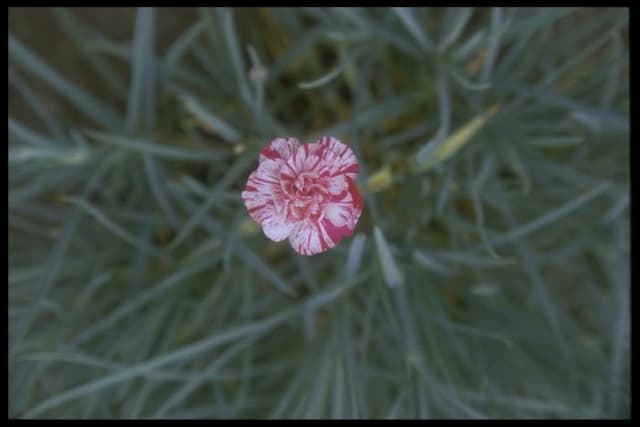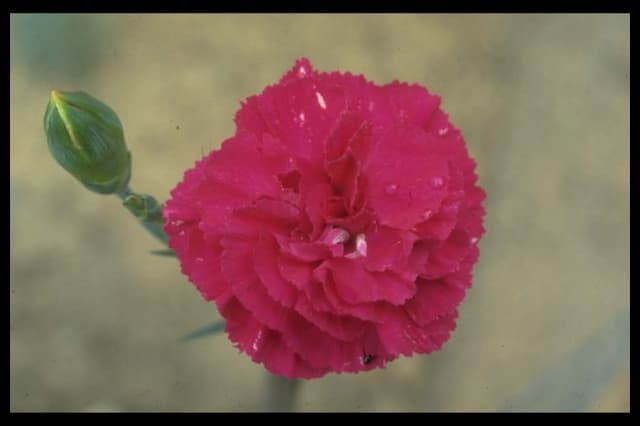Sweet William Dianthus 'Flanders' (b)

ABOUT
The Dianthus 'Flanders' is a captivating plant with a bushy, clump-forming habit that showcases slender, linear leaves with a blue-green to gray-green hue, creating a fine-textured backdrop for the blossoms. The flowers themselves are a standout feature, presenting a traditional five-petal form reminiscent of a frilled or serrated edge. They are renowned for their delightful fragrance and appear in a vibrant array of colors including red, pink, and sometimes white with distinctive patterns or marks that can include a single color or a stunning bicolor combination where one color blends into another. The blooms are typically held aloft on sturdy stems that rise above the foliage, creating an appealing contrast and adding a touch of cottage garden charm to any planting. The plant is often celebrated for its extended blooming period which can grace gardens with color and interest throughout the suitable seasons.
About this plant
 Names
NamesFamily
Caryophyllaceae
Synonyms
Flanders Pinks, Flanders Carnation
Common names
Dianthus 'Flanders'
 Toxicity
ToxicityTo humans
Carnation is generally not considered toxic to humans. Ingesting parts of the plant typically does not lead to serious poisoning. However, as with many plants, if ingested in large quantities, it might cause mild gastrointestinal discomfort, such as nausea or upset stomach.
To pets
Carnation is also not particularly toxic to pets. It is not known to cause serious harm if pets ingest parts of the plant. However, like in humans, consuming large amounts could potentially result in mild gastrointestinal upset in some animals.
 Characteristics
CharacteristicsLife cycle
Perennials
Foliage type
Evergreen
Color of leaves
Blue-green
Flower color
Red
Height
1-2 feet (30-60 cm)
Spread
1 foot (30 cm)
Plant type
Herb
Hardiness zones
3-9
Native area
Europe
Benefits
 General Benefits
General Benefits- Aesthetic Appeal: The Dianthus 'Flanders', commonly known as Sweet William, offers vibrant colors that enhance the visual appeal of gardens and landscapes.
- Attracts Pollinators: Sweet William flowers attract bees, butterflies, and other beneficial pollinators, promoting biodiversity in the garden.
- Easy to Grow: Sweet William is known for being an easy-to-grow plant, making it suitable for gardeners of all skill levels.
- Long Blooming Season: It typically has a long flowering period, providing color and interest in the garden for an extended time.
- Drought Tolerance: Once established, Sweet William shows a degree of drought resistance, making it suitable for dry or xeriscape gardens.
- Wide Range of Uses: The plant is ideal for borders, cottage gardens, and as cut flowers for indoor arrangements.
- Fragrance: Sweet William emits a delightful fragrance, which can add a pleasant sensory experience to any outdoor space.
- Deer Resistance: It is generally resistant to deer, reducing the likelihood of damage from wildlife grazing in the garden.
- Edible Parts: Some parts of the Sweet William plant are edible and can be used in salads or as garnishes, although they are not commonly consumed.
 Medical Properties
Medical PropertiesThis plant is not used for medical purposes.
 Air-purifying Qualities
Air-purifying QualitiesThis plant is not specifically known for air purifying qualities.
 Other Uses
Other Uses- Carnation 'Flanders' petals can be used to create natural dyes, providing a range of colors from yellows to greens depending on the mordant used.
- The plant can be cultivated for use in educational environments, helping students learn about plant biology, hybridization, and garden design.
- Carnation 'Flanders' cut flowers can be used in crafting, such as making bookmarks or pressed flower art.
- The strong stems of Carnation 'Flanders' make it suitable for making lightweight plant supports for other, less sturdy plants in the garden.
- The fragrant flowers of the Carnation 'Flanders' can be used in potpourris, adding a lasting sweet fragrance to a room.
- Dried Carnation 'Flanders' flowers can be used in homemade sachets to freshen up closets and drawers.
- The distinctive look of Carnation 'Flanders' blooms can be used as a natural, decorative topping for cakes and desserts, especially when crystallized with sugar.
- The Carnation 'Flanders' can be grown as part of a butterfly garden, attracting pollinators with its vibrant flowers and sweet nectar.
- Used in photography or painting, the striking Carnation 'Flanders' can provide an excellent subject or backdrop due to its rich colors and textures.
- Carnation 'Flanders' can be utilized for festive decorations during holidays, such as making natural Christmas wreaths or Valentine's Day bouquets.
Interesting Facts
 Feng Shui
Feng ShuiThe Sweet William is not used in Feng Shui practice.
 Zodiac Sign Compitability
Zodiac Sign CompitabilityThe Sweet William is not used in astrology practice.
 Plant Symbolism
Plant Symbolism- Remembrance: The Dianthus 'Flanders', commonly known as the "Flanders Poppy," is a symbol of remembrance, particularly in connection to those who lost their lives during World War I. It grew on the battlefields after the war ended, which made it an emblem for remembering the fallen.
- Resilience: Flanders Poppies are known for their ability to bloom in disturbed soils, like those found on the battlefields, which makes them a symbol of resilience in the face of adversity.
- Sacrifice: The red color of the Flanders Poppy is often associated with the blood shed by soldiers, symbolizing their sacrifice during times of war.
- Peace: After WWI, the Flanders Poppy also became a sign of peace, with the hope that wars would end, and that peace would prevail.
 Water
WaterCarnations require regular watering to keep the soil evenly moist but not waterlogged. Water them deeply to soak the soil to a depth of at least 6 inches, which usually means using about 1 gallon of water per plant every week, depending on weather conditions. During hot or dry weather, you may need to water them twice a week, but always check the soil moisture before watering. Avoid overhead watering to prevent fungal diseases, instead direct water at the base of the plant. Be cautious not to over-water, as this can cause root rot.
 Light
LightCarnations thrive best in full sun conditions where they can receive a minimum of 6 to 8 hours of direct sunlight daily. They should be placed in a spot that gets ample morning light and some light shade during the harshest afternoon sun if located in extremely hot climates. The bright light helps carnations grow lush and promotes vigorous blooming.
 Temperature
TemperatureCarnations prefer a temperate climate with temperatures ranging between 60 and 70 degrees Fahrenheit. They can survive minimum temperatures down to about 40 degrees Fahrenheit and maximum temperatures up to around 85 degrees Fahrenheit. To ensure healthy growth and blooming, it's important to protect carnations from extreme cold and heat.
 Pruning
PruningPruning carnations is important to promote bushy growth and prevent legginess. They should be pruned lightly after the first flush of blooms to encourage a second bloom period. Prune back to above a set of leaves or a growth node to foster new growth and more flowers. The best time to prune for shaping the plant is in early spring.
 Cleaning
CleaningAs needed
 Soil
SoilSweet William prefers well-draining soil with loamy to sandy composition. A mix of two parts garden soil, one part sand or perlite, and one part compost or well-rotted manure is ideal. The soil pH should be neutral to slightly alkaline, between 6.5 and 7.5.
 Repotting
RepottingSweet William is typically not repotted often as it is a short-lived perennial or biennial. Repotting can be done every 1-2 years or when the plant outgrows its current container, but many gardeners choose to replace the plant after it completes its blooming cycle.
 Humidity & Misting
Humidity & MistingSweet William tolerates a wide range of humidity conditions and does not require high humidity levels. Average room humidity is generally sufficient for this plant, and there is no need to artificially increase humidity levels around it.
 Suitable locations
Suitable locationsIndoor
Place Sweet William near a sunny window and water regularly.
Outdoor
Plant Sweet William in well-drained soil with full sun exposure.
Hardiness zone
3-9 USDA
 Life cycle
Life cycleThe life cycle of the Dianthus 'Flanders', commonly known as Sweet William, begins with seed germination, which is best in cool temperatures and usually occurs in spring or fall. After germination, the seedlings develop into a rosette of leaves close to the ground, preparing for the vegetative growth stage. As the plant matures, it develops stems and foliage, followed by flowering in late spring to early summer, characterized by clusters of fragrant flowers that can be pink, red, white, or bicolor. After pollination, often by bees or butterflies, the flowers develop into seed capsules, which, upon drying, release seeds for dispersal. If conditions permit, the plant may self-seed or can be propagated by cuttings or division for the next generation. Sweet William is often grown as a biennial, meaning it completes its life cycle over two years, with the first-year primarily spent growing vegetatively and the second year flowering and seeding.
 Propogation
PropogationPropogation time
Spring-early summer
The Dianthus 'Flanders', commonly known as Sweet William, is usually propagated through seed sowing. The best time to sow Sweet William seeds is in late spring to early summer. The seeds should be sprinkled onto the surface of a well-drained seed mix and lightly covered with soil, as they require light to germinate. The container should then be placed in a warm location with an ideal temperature of about 65 to 70 degrees Fahrenheit (18 to 21 degrees Celsius). Seedlings typically emerge in two to three weeks and can be transplanted outdoors once there's no risk of frost. It is important to acclimate the young plants gradually to outdoor conditions before planting them in their final position.






![Pink [Coconut Sundae]](/_next/image?url=https%3A%2F%2Fplants-admin.emdemapps.com%2Fimages%2Fplants%2F%2Fimages%2F604b5d09d4fd1.png&w=640&q=75)


